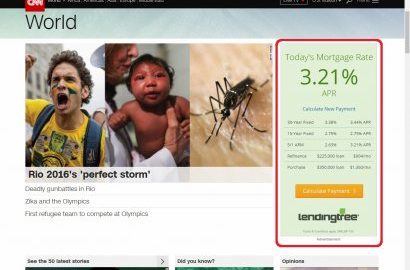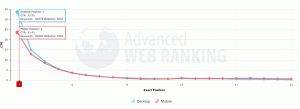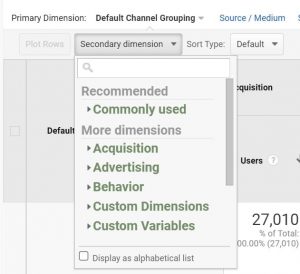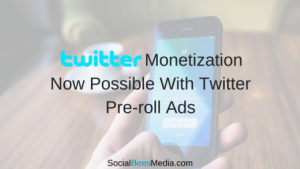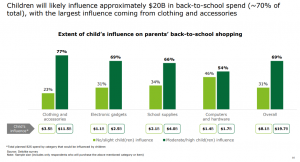
Creating a display advertisement can be a great way to get your brand noticed and generate attention to your products. But before you get started, you need to know exactly how much space is available and what you want to say or want seen at a glance. Creating a stellar ad might not result in an immediate click — after all, over 80% of display ads are ignored — but they can be the key to creating awareness and attention for your business.
You usually only have a small amount of space on the web page to capture the user’s attention, so you’ll need to make sure your display ad is noticeable.
What Is a Display Ad Exactly?
 Display ads, sometimes called banners, are advertisements you create using text, pictures, video, or audio elements. These ads tend to showcase brands and their current promotions and are often used to boost brand awareness, engage with customers, or retarget previous visitors. They can appear in different size boxes anywhere on a web page, though they’re usually seen around the top, bottom, and sides.
Display ads, sometimes called banners, are advertisements you create using text, pictures, video, or audio elements. These ads tend to showcase brands and their current promotions and are often used to boost brand awareness, engage with customers, or retarget previous visitors. They can appear in different size boxes anywhere on a web page, though they’re usually seen around the top, bottom, and sides.
It can be tricky trying to figure out what size and kind of display ad you want to create for your campaign. But if you’re just getting started, don’t be overwhelmed. Here are four steps to mastering your first display ad.
1. Choosing an Ad Size
It is extremely important to choose the right ad size for your creative. If you choose the wrong ad size, it could look totally unappealing and get passed over, or look so bad the viewer writes your brand off.
You only get so much space and the majority of ads use the same standard sizes, so making your ad appealing to the eye is essential to your success. What is it that you want to show? Do you have mostly text or want something with more elaborate graphics? These are things to think about when deciding on what ad size will work best with your message.
Common ad sizes include:
- Leaderboard (728×90 pixels). This banner ad is located at the top or bottom of the page and stretches across the width of the page.
- Banner (468×60). A banner looks like a smaller leaderboard. It is often located at the top or bottom of a page.
- Medium or Large Rectangle (300×250) or (336×280). The rectangles are boxlike ads that are placed in between different sections of text.
- Skyscraper or Wide Skyscraper (120×600) or (160×600). A tall ad that will run down either side of the page.
- Button #1 (120×90) or #2 (120×60). Buttons are small and box-like. They don’t display much in regards to graphics or text but provide you with a link to your site.

Source: Manydesign
Medium rectangle, leaderboard, and the wide skyscraper are the top three sizes that are picked up by publishers for their websites. These three sizes make up 78% of the sizes people decide to create.
2. What Display Ad Creative Meets Your Need
Now that you have chosen your size, how “flashy” do you want it to be? Are you going to want a static or dynamic creative?
A static display ad offers no movement or interaction. By clicking on the text or image, you’ll redirect to the ad’s landing page.
With a dynamic display ad, you can show a creative through an animated, interactive, video, or expanding advertisement.
- Animated Ad. An animated ad will incorporate movement within the ad to be more eye-catching. Movements in GIF or Flash formats appear and can take up the whole ad space, or just part of it
- Interactive Advertisements. These give the user the ability to control how the ad responds. There are different types of interactive ads to consider. Some of the best interactive ads incorporate games, animations, or quizzes before directing users to their websites.
- Expanding Ad. An expanding ad will increase in size if you click or move the cursor over it. This can start as a static display and turn into something way more dynamic by incorporating other types of ads like a video.
- Video Ad. Another motion-oriented ad to consider. It can play as soon as the site is displayed, or can be user activated.
Since there are a variety of options to choose from, you probably want to look at the whole marketing campaign and what your goals are. It can also help to see what types of ads your competitors use and if that style works for them.
3. Mobile Display Ad Creatives and Sizes
Mobile ad creatives are very similar to desktop ones – including standard banner, expandable, and video advertisements.
Sizes for mobile ads include:
- Banners. 320×50 or 300×50.
- Interstitial. 320×480, 300×400, or 300×250.
- Expandable. Can be any of the sizes above, transforming into another size (e.g. 300×50 expands to 300×400).
Interstitial ads can cover the whole screen, which will allow for more content to be added and seen. They usually pop up in a natural flow point like the changing between activities or before going to the next level of a game.

Source: AdStage
Facebook Carousel ads are a fantastic option to consider for generating traffic via oh-so-popular social media. This allows you to create an ad that showcases 3-5 images or videos — including headlines, links, and calls-to-action — by having users swipe on handheld devices or click arrows on desktop. The ad is featured in the News Feed and is set up to take you to a landing page. This option is available for advertising on Instagram too.

Source: Facebook
Facebook Canvas ads are a little different in that they allow for full-screen rich media ads in-app once you tap on them, expanding natively in Facebook rather than taking you directly to a landing page. They appear within the feed as well and feature many interactive elements.

Source: Facebook
4. DIY Tools to Create Your Ads
Bannersnack is a service that helps you create display ads, featuring different templates, fonts, and stock photos available for you. It is easy to use, allows for downloads in various types of files (PNG, JPG, GIF, and Flash), and uses its own analytics for tracking. Their service is not free, though — plans could cost up to $ 24 per month.
Canva is a great tool that helps you create your display ad on their website or app. It’s pretty easy to use. You choose the layout you want, upload your own photos (or choose from their stock images), add filters and text, and then save and place it. Pretty simple right? It’s affordable too — Canva is free to use, unless you choose to buy one of their premium stock photos, which cost as little as $ 1 each.
Snappa.io, like the others, makes it as easy as possible for non-designers to design display ads. You go in and select a template, and replace images and text with what you want. It provides you with a lot of visual elements you can choose from. They also have pre-tailored dimensions to make it easy to select the size you want. You can manage and store your creatives right on the site, along with being able to share your creatives or even schedule when to post right from their platform.
If you go with the no-cost option, you’re a little more limited in features. But under their Pro plan, you are able to have unlimited design features and have access to the site’s additional services. However, you aren’t able to do flash or rich media formats — it’s all static ads.
If you’re new to display advertising, Canva and Snappa.io give you the option to make free creatives for your campaign. If you have a bit more budget, the pricier options give you the ability to make better designs. You could also outsource your display creatives. These are all options to consider before jumping into your first display campaign.
Business & Finance Articles on Business 2 Community(120)
